Which Layer Is The Thickest

Earth's axial tilt (obliquity) is currently about 23.4°.
In astronomy, centric tilt, also known as obliquity, is the angle between an object'south rotational axis and its orbital axis, which is the line perpendicular to its orbital plane; equivalently, it is the bending between its equatorial plane and orbital plane.[1] It differs from orbital inclination. At an obliquity of 0 degrees, the two axes point in the same direction; that is, the rotational axis is perpendicular to the orbital plane.
The rotational axis of Earth, for case, is the imaginary line that passes through both the North Pole and South Pole, whereas the Globe'southward orbital axis is the line perpendicular to the imaginary aeroplane through which the Globe moves as information technology revolves effectually the Sunday; the World's obliquity or centric tilt is the angle between these ii lines. Earth's obliquity oscillates between 22.1 and 24.5 degrees[2] on a 41,000-twelvemonth bike. Based on a continuously updated formula (hither Laskar, 1986, though since 2006 the IMCCE and the IAU recommend the P03 model), Globe's hateful obliquity (without taking into account the nutation in obliquity) is currently well-nigh 23°26′ten.8″ (or 23.43633°) and decreasing; according to P03 astronomical model, its value (without taking into account the nutation in obliquity) was 23°26′11.570″ (23.4365472133°) on January 1, 2021, 0 TT.
Over the grade of an orbital period, the obliquity usually does not change considerably, and the orientation of the axis remains the same relative to the groundwork of stars. This causes one pole to be pointed more toward the Lord's day on one side of the orbit, and more abroad from the Sun on the other side—the cause of the seasons on Earth.
Standards [edit]
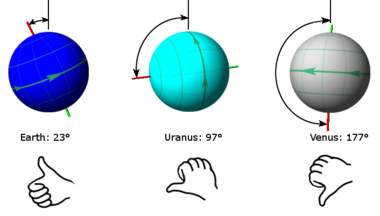
The positive pole of a planet is defined by the right-hand rule: if the fingers of the correct hand are curled in the direction of the rotation and so the thumb points to the positive pole. The axial tilt is divers equally the bending between the direction of the positive pole and the normal to the orbital airplane. The angles for Earth, Uranus, and Venus are approximately 23°, 97°, and 177° respectively.
There are two standard methods of specifying a planet'south tilt. One fashion is based on the planet's north pole, divers in relation to the management of Earth'south north pole, and the other way is based on the planet's positive pole, defined by the right-hand rule:
- The International Astronomical Union (IAU) defines the north pole of a planet as that which lies on Earth'due south north side of the invariable plane of the Solar System;[iii] under this system, Venus is tilted 3° and rotates retrograde, opposite that of most of the other planets.[4] [5]
- The IAU likewise uses the right-mitt rule to define a positive pole [6] for the purpose of determining orientation. Using this convention, Venus is tilted 177° ("upside down") and rotates prograde.
Earth [edit]
World'southward orbital aeroplane is known as the ecliptic plane, and Earth'southward tilt is known to astronomers as the obliquity of the ecliptic, being the bending betwixt the ecliptic and the celestial equator on the angelic sphere.[vii] It is denoted by the Greek letter ε.
Earth currently has an axial tilt of nigh 23.44°.[8] This value remains about the same relative to a stationary orbital airplane throughout the cycles of axial precession.[ix] But the ecliptic (i.e., Earth's orbit) moves due to planetary perturbations, and the obliquity of the ecliptic is not a fixed quantity. At present, it is decreasing at a rate of almost 46.8″[10] per century (see details in Curt term below).
History [edit]
World's obliquity may have been reasonably accurately measured as early as 1100 BC in India and China.[11] The aboriginal Greeks had good measurements of the obliquity since nearly 350 BC, when Pytheas of Marseilles measured the shadow of a gnomon at the summer solstice.[12] About 830 Advertizement, the Caliph Al-Mamun of Baghdad directed his astronomers to measure the obliquity, and the result was used in the Arab world for many years.[13] In 1437, Ulugh Beg determined the World's centric tilt equally 23°30′17″ (23.5047°).[14]
It was widely believed, during the Middle Ages, that both precession and Globe'southward obliquity oscillated around a mean value, with a catamenia of 672 years, an idea known as trepidation of the equinoxes. Perhaps the beginning to realize this was incorrect (during historic time) was Ibn al-Shatir in the fourteenth century[fifteen] and the get-go to realize that the obliquity is decreasing at a relatively abiding charge per unit was Fracastoro in 1538.[xvi] The first authentic, mod, western observations of the obliquity were probably those of Tycho Brahe from Kingdom of denmark, about 1584,[17] although observations by several others, including al-Ma'mun, al-Tusi,[eighteen] Purbach, Regiomontanus, and Walther, could have provided similar data.
Seasons [edit]

The centrality of Globe remains oriented in the same direction with reference to the background stars regardless of where information technology is in its orbit. Northern hemisphere summer occurs at the right side of this diagram, where the north pole (blood-red) is directed toward the Sun, winter at the left.
Earth's axis remains tilted in the aforementioned direction with reference to the background stars throughout a yr (regardless of where information technology is in its orbit). This means that one pole (and the associated hemisphere of World) will be directed away from the Sunday at one side of the orbit, and one-half an orbit after (one-half a year later) this pole volition be directed towards the Lord's day. This is the crusade of World's seasons. Summer occurs in the Northern hemisphere when the north pole is directed toward the Sun. Variations in Earth's axial tilt can influence the seasons and is likely a gene in long-term climatic change (too see Milankovitch cycles).

Human relationship between Earth's axial tilt (ε) to the tropical and polar circles
Oscillation [edit]
Short term [edit]
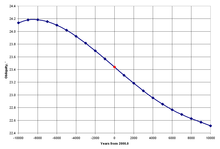
Obliquity of the ecliptic for 20,000 years, from Laskar (1986). The cherry indicate represents the twelvemonth 2000.
The exact angular value of the obliquity is found by observation of the motions of Earth and planets over many years. Astronomers produce new central ephemerides as the accuracy of observation improves and as the understanding of the dynamics increases, and from these ephemerides diverse astronomical values, including the obliquity, are derived.
Almanac almanacs are published list the derived values and methods of use. Until 1983, the Astronomical Almanac's angular value of the hateful obliquity for any date was calculated based on the piece of work of Newcomb, who analyzed positions of the planets until nearly 1895:
- ε = 23°27′eight.26″ − 46.845″ T − 0.0059″ T ii + 0.00181 ″ T iii
where ε is the obliquity and T is tropical centuries from B1900.0 to the date in question.[nineteen]
From 1984, the Jet Propulsion Laboratory'south DE series of estimator-generated ephemerides took over as the central ephemeris of the Astronomical Almanac. Obliquity based on DE200, which analyzed observations from 1911 to 1979, was calculated:
- ε = 23°26′21.448″ − 46.8150″ T − 0.00059″ T 2 + 0.001813 ″ T 3
where hereafter T is Julian centuries from J2000.0.[20]
JPL's key ephemerides have been continually updated. For instance, co-ordinate to IAU resolution in 2006 in favor of the P03 astronomical model, the Astronomical Almanac for 2010 specifies:[21]
- ε = 23°26′21.406″ − 46.836769 ″ T − 0.0001831 ″ T 2 + 0.002003 40 ″ T 3 − 5.76″ × 10−7 T 4 − 4.34″ × 10−8 T 5
These expressions for the obliquity are intended for high precision over a relatively short fourth dimension span, maybe ± several centuries.[22] J. Laskar computed an expression to order T ten good to 0.02″ over grand years and several arcseconds over x,000 years.
- ε = 23°26′21.448″ − 4680.93″ t − 1.55″ t two + 1999.25″ t iii − 51.38″ t four − 249.67″ t 5 − 39.05″ t 6 + 7.12″ t 7 + 27.87″ t eight + v.79″ t ix + 2.45″ t ten
where here t is multiples of 10,000 Julian years from J2000.0.[23]
These expressions are for the so-chosen mean obliquity, that is, the obliquity costless from short-term variations. Periodic motions of the Moon and of Earth in its orbit crusade much smaller (9.2 arcseconds) brusk-period (nearly 18.6 years) oscillations of the rotation axis of World, known as nutation, which add a periodic component to World's obliquity.[24] [25] The truthful or instantaneous obliquity includes this nutation.[26]
Long term [edit]
Using numerical methods to simulate Solar Organisation behavior, long-term changes in Earth's orbit, and hence its obliquity, have been investigated over a flow of several meg years. For the past v million years, Earth's obliquity has varied between 22°2′33″ and 24°30′16″, with a mean catamenia of 41,040 years. This cycle is a combination of precession and the largest term in the motion of the ecliptic. For the next i million years, the wheel will carry the obliquity between 22°13′44″ and 24°20′50″.[27]
The Moon has a stabilizing effect on Earth's obliquity. Frequency map analysis conducted in 1993 suggested that, in the absence of the Moon, the obliquity could change rapidly due to orbital resonances and chaotic behavior of the Solar System, reaching as loftier as 90° in as fiddling every bit a few 1000000 years (besides see Orbit of the Moon).[28] [29] However, more than recent numerical simulations[30] made in 2011 indicated that fifty-fifty in the absence of the Moon, World'due south obliquity might non be quite so unstable; varying only by about 20–25°. To resolve this contradiction, diffusion rate of obliquity has been calculated, and it was constitute that it takes more than billions of years for Earth'southward obliquity to reach near 90°.[31] The Moon's stabilizing effect volition continue for less than 2 billion years. As the Moon continues to recede from Earth due to tidal acceleration, resonances may occur which will cause large oscillations of the obliquity.[32]
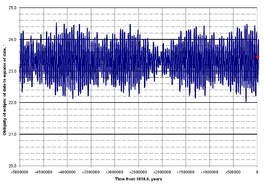
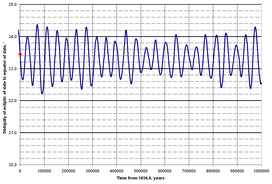
Long-term obliquity of the ecliptic. Left: for the past 5 1000000 years; annotation that the obliquity varies just from most 22.0° to 24.v°. Correct: for the next i million years; notation the approx. 41,000-year period of variation. In both graphs, the red point represents the twelvemonth 1850. (Source: Berger, 1976).
Solar System bodies [edit]
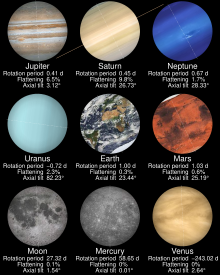
Comparison of the rotation catamenia (sped upward x 000 times, negative values denoting retrograde), flattening and centric tilt of the planets and the Moon (SVG animation)
All four of the innermost, rocky planets of the Solar System may have had big variations of their obliquity in the past. Since obliquity is the angle between the axis of rotation and the direction perpendicular to the orbital plane, it changes as the orbital plane changes due to the influence of other planets. But the centrality of rotation can also motility (axial precession), due to torque exerted past the Sun on a planet's equatorial bulge. Like Earth, all of the rocky planets show centric precession. If the precession charge per unit were very fast the obliquity would actually remain fairly constant even as the orbital plane changes.[33] The rate varies due to tidal dissipation and cadre-mantle interaction, among other things. When a planet'southward precession rate approaches certain values, orbital resonances may cause large changes in obliquity. The amplitude of the contribution having 1 of the resonant rates is divided by the departure between the resonant charge per unit and the precession rate, so information technology becomes large when the ii are similar.[33]
Mercury and Venus take virtually likely been stabilized past the tidal dissipation of the Sunday. Earth was stabilized by the Moon, as mentioned higher up, just before its germination, Earth, too, could have passed through times of instability. Mars'south obliquity is quite variable over millions of years and may be in a chaotic state; information technology varies every bit much equally 0° to 60° over some millions of years, depending on perturbations of the planets.[28] [34] Some authors dispute that Mars'south obliquity is cluttered, and show that tidal dissipation and viscid core-mantle coupling are acceptable for it to have reached a fully damped country, similar to Mercury and Venus.[four] [35]
The occasional shifts in the centric tilt of Mars have been suggested as an explanation for the advent and disappearance of rivers and lakes over the course of the beingness of Mars. A shift could crusade a burst of methane into the atmosphere, causing warming, merely then the methane would be destroyed and the climate would become arid again.[36] [37]
The obliquities of the outer planets are considered relatively stable.
| Body | NASA, J2000.0[38] epoch | IAU, 0h 0 January 2010 TT[39] epoch | ||||||
|---|---|---|---|---|---|---|---|---|
| Axial tilt (degrees) | North Pole | Rotational period (hours) | Axial tilt (degrees) | North Pole | Rotation (deg./twenty-four hours) | |||
| R.A. (degrees) | December. (degrees) | R.A. (degrees) | December. (degrees) | |||||
| Sunday | 7.25 | 286.13 | 63.87 | 609.12[A] | 7.25[B] | 286.xv | 63.89 | fourteen.xviii |
| Mercury | 0.03 | 281.01 | 61.41 | 1407.6 | 0.01 | 281.01 | 61.45 | 6.fourteen |
| Venus | 2.64 | 272.76 | 67.xvi | −5832.six | 2.64 | 272.76 | 67.xvi | −i.48 |
| Earth | 23.44 | 0.00 | 90.00 | 23.93 | 23.44 | Undefined | 90.00 | 360.99 |
| Moon | 6.68 | — | — | 655.73 | 1.54[C] | 270.00 | 66.54 | 13.18 |
| Mars | 25.xix | 317.68 | 52.89 | 24.62 | 25.19 | 317.67 | 52.88 | 350.89 |
| Jupiter | 3.13 | 268.06 | 64.l | 9.93[D] | iii.12 | 268.06 | 64.50 | 870.54[D] |
| Saturn | 26.73 | 40.59 | 83.54 | 10.66[D] | 26.73 | xl.59 | 83.54 | 810.79[D] |
| Uranus | 82.23 | 257.31 | −xv.xviii | −17.24[D] | 82.23 | 257.31 | −15.18 | −501.16[D] |
| Neptune | 28.32 | 299.33 | 42.95 | 16.11[D] | 28.33 | 299.forty | 42.95 | 536.31[D] |
| Pluto[E] | 57.47 | 312.99[East] | 6.xvi[East] | −153.29 | 60.41 | 312.99 | 6.sixteen | −56.36 |
| ||||||||
[edit]
| | This department needs to exist updated. The reason given is: Kepler mission concluded in 2018. (March 2022) |
The stellar obliquity ψ s , i.e. the centric tilt of a star with respect to the orbital plane of ane of its planets, has been determined for only a few systems. But for 49 stars equally of 2012, the sky-projected spin-orbit misalignment λ has been observed,[40] which serves as a lower limit to ψ s . Most of these measurements rely on the Rossiter–McLaughlin effect. So far, it has not been possible to constrain the obliquity of an extrasolar planet. But the rotational flattening of the planet and the entourage of moons and/or rings, which are traceable with high-precision photometry, e.one thousand. past the space-based Kepler space telescope, could provide access to ψ p [ clarification needed ] in the near future.
Astrophysicists accept applied tidal theories to predict the obliquity of extrasolar planets. It has been shown that the obliquities of exoplanets in the habitable zone effectually low-mass stars tend to be eroded in less than 109 years,[41] [42] which means that they would not have seasons as Earth has.
Encounter also [edit]
- Milankovitch cycles
- Polar movement
- Rotation around a fixed centrality
- True polar wander
References [edit]
- ^ U.S. Naval Observatory Nautical Annual Office (1992). P. Kenneth Seidelmann (ed.). Explanatory Supplement to the Astronomical Almanac. University Scientific discipline Books. p. 733. ISBN978-0-935702-68-2.
- ^ "Globe Is tilted". timeanddate.com . Retrieved 25 August 2017.
- ^ Explanatory Supplement 1992, p. 384
- ^ a b Correia, Alexandre C. M.; Laskar, Jacques; de Surgy, Olivier Néron (May 2003). "Long-term evolution of the spin of Venus I. theory" (PDF). Icarus. 163 (1): i–23. Bibcode:2003Icar..163....1C. doi:10.1016/S0019-1035(03)00042-3. Archived (PDF) from the original on 9 October 2022.
- ^ Correia, A. C. M.; Laskar, J. (2003). "Long-term development of the spin of Venus: Two. numerical simulations" (PDF). Icarus. 163 (1): 24–45. Bibcode:2003Icar..163...24C. doi:10.1016/S0019-1035(03)00043-5. Archived (PDF) from the original on 9 October 2022.
- ^ Seidelmann, P. Kenneth; Archinal, B. A.; a'Hearn, G. F.; Conrad, A.; Consolmagno, G. J.; Hestroffer, D.; Hilton, J. 50.; Krasinsky, Thousand. A.; Neumann, Yard.; Oberst, J.; Stooke, P.; Tedesco, East. F.; Tholen, D. J.; Thomas, P. C.; Williams, I. P. (2007). "Report of the IAU/IAG Working Group on cartographic coordinates and rotational elements: 2006". Angelic Mechanics and Dynamical Astronomy. 98 (three): 155–180. Bibcode:2007CeMDA..98..155S. doi:10.1007/s10569-007-9072-y.
- ^ U.S. Naval Observatory Nautical Almanac Part; U.Thou. Hydrographic Office; H.Thousand. Nautical Annual Role (2008). The Astronomical Almanac for the Year 2010. US Authorities Printing Part. p. M11. ISBN978-0-7077-4082-9.
- ^ "Glossary" in Astronomical Almanac Online. (2018). Washington DC: Usa Naval Observatory. south.v. obliquity.
- ^ Chauvenet, William (1906). A Manual of Spherical and Practical Astronomy. Vol. 1. J. B. Lippincott. pp. 604–605.
- ^ Ray, Richard D.; Erofeeva, Svetlana Y. (4 February 2014). "Long‐period tidal variations in the length of twenty-four hour period". Journal of Geophysical Research: Solid World. 119 (ii): 1498–1509. Bibcode:2014JGRB..119.1498R. doi:ten.1002/2013JB010830.
- ^ Wittmann, A. (1979). "The Obliquity of the Ecliptic". Astronomy and Astrophysics. 73 (1–ii): 129–131. Bibcode:1979A&A....73..129W.
- ^ Gore, J. E. (1907). Astronomical Essays Historical and Descriptive. Chatto & Windus. p. 61.
- ^ Marmery, J. V. (1895). Progress of Science. Chapman and Hall, ld. p. 33.
- ^ Sédillot, Fifty.P.E.A. (1853). Prolégomènes des tables astronomiques d'OlougBeg: Traduction et commentaire. Paris: Firmin Didot Frères. pp. 87 & 253.
- ^ Saliba, George (1994). A History of Arabic Astronomy: Planetary Theories During the Golden Historic period of Islam. p. 235.
- ^ Dreyer, J. L. E. (1890). Tycho Brahe. A. & C. Black. p. 355.
- ^ Dreyer (1890), p. 123
- ^ Sayili, Aydin (1981). The Observatory in Islam. p. 78.
- ^ U.Due south. Naval Observatory Nautical Annual Role; H.M. Nautical Almanac Office (1961). Explanatory Supplement to the Astronomical Ephemeris and the American Ephemeris and Nautical Almanac. H.M. Stationery Office. Section 2B.
- ^ U.Southward. Naval Observatory; H.Yard. Nautical Annual Office (1989). The Astronomical Almanac for the Year 1990. US Government Printing Office. p. B18. ISBN978-0-11-886934-8.
- ^ Astronomical Almanac 2010, p. B52
- ^ Newcomb, Simon (1906). A Compendium of Spherical Astronomy. MacMillan. pp. 226–227.
- ^ See table eight and eq. 35 in Laskar, J. (1986). "Secular terms of classical planetary theories using the results of general theory". Astronomy and Astrophysics. 157 (1): 59–70. Bibcode:1986A&A...157...59L. and erratum to article Laskar, J. (1986). "Erratum: Secular terms of classical planetary theories using the results of general theory". Astronomy and Astrophysics. 164: 437. Bibcode:1986A&A...164..437L. Units in article are arcseconds, which may exist more user-friendly.
- ^ Explanatory Supplement (1961), sec. 2C
- ^ "Basics of Space Flight, Chapter 2". Jet Propulsion Laboratory/NASA. 29 October 2013. Retrieved 26 March 2015.
- ^ Meeus, Jean (1991). "Chapter 21". Astronomical Algorithms. Willmann-Bell. ISBN978-0-943396-35-four.
- ^ Berger, A.L. (1976). "Obliquity and Precession for the Last 5000000 Years". Astronomy and Astrophysics. 51 (ane): 127–135. Bibcode:1976A&A....51..127B.
- ^ a b Laskar, J.; Robutel, P. (1993). "The Cluttered Obliquity of the Planets" (PDF). Nature. 361 (6413): 608–612. Bibcode:1993Natur.361..608L. doi:ten.1038/361608a0. S2CID 4372237. Archived from the original (PDF) on 23 November 2012.
- ^ Laskar, J.; Joutel, F.; Robutel, P. (1993). "Stabilization of the Globe'due south Obliquity past the Moon" (PDF). Nature. 361 (6413): 615–617. Bibcode:1993Natur.361..615L. doi:ten.1038/361615a0. S2CID 4233758. Archived (PDF) from the original on 9 Oct 2022.
- ^ Lissauer, J.J.; Barnes, J.W.; Chambers, J.East. (2011). "Obliquity variations of a moonless World" (PDF). Icarus. 217 (1): 77–87. Bibcode:2012Icar..217...77L. doi:10.1016/j.icarus.2011.10.013.
- ^ Li, Gongjie; Batygin, Konstantin (20 July 2014). "On the Spin-centrality Dynamics of a Moonless World". Astrophysical Journal. 790 (1): 69–76. arXiv:1404.7505. Bibcode:2014ApJ...790...69L. doi:10.1088/0004-637X/790/1/69. S2CID 119295403.
- ^ Ward, W.R. (1982). "Comments on the Long-Term Stability of the Earth's Obliquity". Icarus. fifty (ii–3): 444–448. Bibcode:1982Icar...l..444W. doi:ten.1016/0019-1035(82)90134-8.
- ^ a b William Ward (20 July 1973). "Large-Scale Variations in the Obliquity of Mars". Science. 181 (4096): 260–262. Bibcode:1973Sci...181..260W. doi:10.1126/scientific discipline.181.4096.260. PMID 17730940. S2CID 41231503.
- ^ Touma, J.; Wisdom, J. (1993). "The Chaotic Obliquity of Mars" (PDF). Scientific discipline. 259 (5099): 1294–1297. Bibcode:1993Sci...259.1294T. doi:10.1126/science.259.5099.1294. PMID 17732249. S2CID 42933021.
- ^ Correia, Alexandre C.M; Laskar, Jacques (2009). "Mercury'due south capture into the 3/2 spin-orbit resonance including the outcome of core-drapery friction". Icarus. 201 (1): i–11. arXiv:0901.1843. Bibcode:2009Icar..201....1C. doi:ten.1016/j.icarus.2008.12.034. S2CID 14778204.
- ^ Rebecca Boyle (seven October 2017). "Methane burps on young Mars helped it keep its liquid h2o". New Scientist.
- ^ Edwin Kite; et al. (2 October 2017). "Marsh gas bursts as a trigger for intermittent lake-forming climates on post-Noachian Mars" (PDF). Nature Geoscience. 10 (10): 737–740. arXiv:1611.01717. Bibcode:2017NatGe..10..737K. doi:10.1038/ngeo3033. S2CID 102484593.
- ^ Planetary Fact Sheets, at http://nssdc.gsfc.nasa.gov
- ^ Astronomical Almanac 2010, pp. B52, C3, D2, E3, E55
- ^ Heller, R. "Holt-Rossiter-McLaughlin Encyclopaedia". René Heller. Retrieved 24 Feb 2012.
- ^ Heller, R.; Leconte, J.; Barnes, R. (2011). "Tidal obliquity evolution of potentially habitable planets". Astronomy and Astrophysics. 528: A27. arXiv:1101.2156. Bibcode:2011A&A...528A..27H. doi:x.1051/0004-6361/201015809. S2CID 118784209.
- ^ Heller, R.; Leconte, J.; Barnes, R. (2011). "Habitability of Extrasolar Planets and Tidal Spin Evolution". Origins of Life and Evolution of Biospheres. 41 (6): 539–43. arXiv:1108.4347. Bibcode:2011OLEB...41..539H. doi:10.1007/s11084-011-9252-three. PMID 22139513. S2CID 10154158.
External links [edit]
- National Space Science Data Center
- Seidelmann, P. Kenneth; Archinal, Brent A.; A'Hearn, Michael F.; et al. (2007). "Report of the IAU/IAG Working Group on cartographic coordinates and rotational elements: 2006". Angelic Mechanics and Dynamical Astronomy. 98 (three): 155–180. Bibcode:2007CeMDA..98..155S. doi:10.1007/s10569-007-9072-y.
- Obliquity of the Ecliptic Calculator
Which Layer Is The Thickest,
Source: https://en.wikipedia.org/wiki/Axial_tilt
Posted by: lopezbeforavy43.blogspot.com


0 Response to "Which Layer Is The Thickest"
Post a Comment